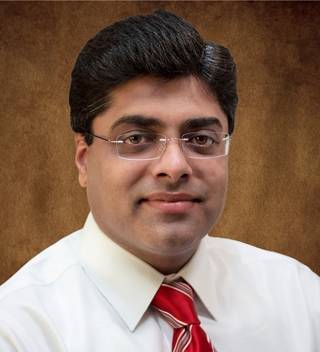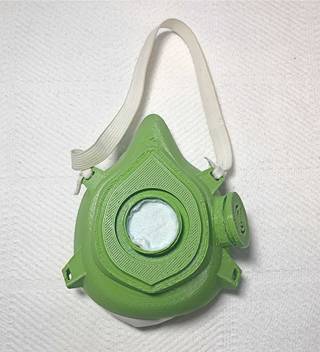When the team that leads the 3D-printing lab at Vanderbilt University Medical Center (VUMC) heard that the nation’s physicians and other healthcare providers on the front lines of the COVID-19 pandemic were running low on personal protective equipment (PPE), they saw an opportunity to help. With many frontline providers forced to reuse single-use N95 masks or even use homemade cloth face coverings as inadequate alternatives to the masks that filter 95% of airborne particles, the team focused on leveraging the lab’s 3D-printing technology to develop a comparable N95 mask substitute. Now, the team is testing their design — which they plan to share freely so that others can easily make the masks using any 3D printer.
Associate Professor of Radiology and Pediatrics Sumit Pruthi, MD, founded VUMC’s 3D-printing lab in 2018 and has been overseeing the N95 mask replacement project since early March of 2020. He is working with a team on the project: diagnostic radiology resident Cameron E. Henry, MD, and 3D engineers Brent D. Griffith and Gary R. Drake. “We became aware that hospitals and other facilities were exhausting their supply of PPE and that frontline physicians and nurses were reusing and trying to sterilize PPE,” says Pruthi, who is also chief of pediatric neuroradiology and pediatric radiology fellowship director at Monroe Carell Jr. Children’s Hospital at Vanderbilt. “We know that without proper equipment, providers are at risk for infection, so we saw it as our moral duty to direct all of our efforts to create something that could either reduce or replace the use of PPE.”

Sumit Pruthi, MD, pediatric radiology fellowship director, radiology and pediatrics associate professor, and chief of pediatric neuroradiology at Monroe Carell Jr. Children’s Hospital at Vanderbilt, is overseeing a project to produce 3D-printed surgical masks in response to the personal protective equipment shortage. |
Recognizing that COVID-19 spreads through airborne particles and that N95 masks were in short supply, Pruthi and his team decided to make a surgical mask that could filter these contagions. Their goal was to design a mask that was simple enough to make on any 3D printer without requiring a lot of material or time. The team ultimately designed a reusable mask made of antimicrobial plastic to cover the wearer’s nose and mouth with two removable valves that hold disposable exhalation and inhalation filters, which can be cut from existing N95 masks.
“We’re basically using the same N95 filtration material that has been tried and tested by the Food and Drug Administration for the exhalation and inhalation areas of the mask, except that we’re using only 1/12 of the N95 material and 3D printing everything else,” Pruthi explains. “With our design, if a physician has three N95 masks, he or she can cut them into 18 different pieces, and those pieces will become, essentially, 18 masks for him or her.”
Leveraging Existing Resources
Pruthi was inspired to develop PPE after he received an email from a company that had designed a 3D-printed, hands-free door opener to help stop the spread of germs that can transmit viruses like those that cause COVID-19. “The company was freely distributing the digital file, which can be used to make the door opener on any 3D printer,” Pruthi says. “When I saw that email, it really piqued my interest, and I thought, ‘We have an established 3D-printing lab; we need to do something like this to help our colleagues in the healthcare community,’ and that’s how it all started. I reached out to the 3D-printing team, and they were eager to help.”
When Henry learned about Pruthi’s plans to develop PPE, he suggested that the team leverage existing materials to make surgical masks. “Given that this is a respiratory illness, I started with the masks because it seems that prevention of the spread of the disease is what’s most important right now. My main goal was to make something that would protect people as both a fluid barrier and a filtration unit,” Henry explains. “That said, we weren’t looking to reinvent the wheel in terms of making a mask from new material. Our goal was to conserve material so that one N95 mask that one would traditionally wear would provide six masks’ worth of materials if allocated correctly and cut appropriately to serve as filters in our 3D-printed mask.”

The reusable mask is made of antimicrobial plastic to cover the wearer’s nose and mouth. |
Along those same lines, Henry and the team didn’t want to spend a lot of time creating a new design from scratch. Instead, they searched a crowd-sharing 3D design website for mask concepts that others had already developed. “We saw several models, and some of the designs were really good structurally, but a lot of them had problems with fit,” Henry explains. “They didn’t work across a variety of faces — be it thin faces or cherub faces. So, we decided to take a model that we thought had a solid foundation and customize it.”
Developing a Prototype
Part of the customization effort involved considering appropriate materials from which to print the masks. They ultimately settled on an antimicrobial plastic called Plactive AN1, which is widely available, relatively inexpensive, and easily manipulated to create a safe and effective fluid barrier. “We wanted to be sure that if we sent our printer file to someone, they would be able to get the material and print the masks with a low-cost printer,” Pruthi explains. “The other thing we considered was the time that it takes to print the masks. In some cases, 3D printing can be time-consuming, especially for complex designs. We wanted a model that is relatively quick to print on pretty much any 3D printer.”

Diagnostic radiology resident Cameron E. Henry, MD, came up with the idea to make surgical masks, recognizing that COVID-19 is a respiratory illness and appropriate masks are critical for protecting frontline healthcare providers. |
The team then concentrated on achieving a universal fit. They used a digital application to scan several face models to create a mask that would fit most face shapes. “I averaged the models to give us a general fit for almost any face type,” Henry says. “But if someone wants to have a more personalized fit, they could use this app with an image of their own face to get a custom fit. We wanted people to have the flexibility to make it their own while ensuring that the mask provides a high level of protection against airborne particles and fluids for most wearers.”
From there, the team fine-tuned the mask’s fit and the inhalation and exhalation valve placement. “We reiterated model after model based on what we thought would make it easy to breathe in and out — with valves that would cover a little bit of the nose and a little bit of the mouth,” Henry says. “We were trying to see where preferentially air goes and where air might leak. We went through at least four or five masks to achieve that preferential airflow with an appropriate seal.”
Testing the Mask
It took the team about two-and-a-half weeks to develop a universal mask prototype. Now they are conducting synthetic blood and saccharin testing to ensure the mask performs as intended. “Testing is critical to make sure the mask is safe for providers to use and that it provides the fluid and filtration barrier that it should,” Pruthi says. “It’s easy to come up with a prototype, but testing is the big hurdle. That’s where being patient, being cautious, and being meticulous come into play.”

The mask has two removable valves that hold disposable exhalation and inhalation filters, which can be cut from existing N95 masks. |
In addition to testing the mask’s performance, the team is also conducting tests to verify that the mask can be replicated on any 3D printer. “We’re really trying to refine the process because you can have five different 3D printers, and you can set them on many different parameters, and you will get microscopic and even macroscopic differences in the mask,” Henry says. “We’re trying to standardize the process so you can print an effective respirator using the pre-defined settings on any 3D printer.”
Sharing the Design
Once all of the testing is completed, the team plans to share their design file with other healthcare providers who need N95-quality masks as they respond to the COVID-19 pandemic and other medical emergencies worldwide. “I’m not looking at this as a one-off for the COVID-19 pandemic and that’s it,” Henry says. “Hundreds of places around the world are constantly under public health crises and don’t have large supply chains at their disposal. I see this project as a step toward expanding 3D-printing in medicine for the long term and reaching populations in need.”
With that in mind, Pruthi says that radiologists are well positioned to lead the expansion of 3D-printed technology in medicine. “Many of the 3D-printing labs in North America, particularly in academic medical centers, are led by radiologists, and that’s because 3D-printing often starts with imaging,” Pruthi explains. “As radiologists, we understand imaging best; therefore, we are the first line of quality control in 3D-printing for medical applications, and we are positioned to contribute. This is a unique opportunity for us as radiologists to meet the needs of providers affected by this PPE shortage and healthcare crises around the globe.”





